Article
Bar Harbor, Maine: Way Up North
Author(s):
Bar Harbor was initially an island only of interest to outdoorsmen and artists. The town came to mean money when wealthy art patrons from New York, Boston and Philadelphia began building "cottages."
Photography by the authors
Maine
is
stands way up, top right on the map, almost in Canada. Maybe it located there because the maniacs sure talk funny. They even get their directions mixed up as when they say they are going Down East. But Maine claims to be the safest place in the United States. With its 1.25 million residents, the state indeed has the lowest crime rate — though its drivers do kill a lot of moose and sometimes themselves when they hit those colossal creatures on the highways.
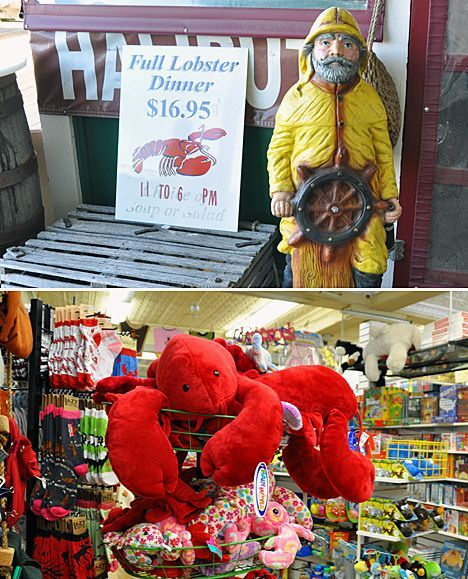
The main industries in this state are tourism, fishing and boat building, in that order. The low-key people of Maine sometimes seem bemused by tourists’ interest in this wooded, rocky and somewhat remote part of the world, hence the story about the old Maine farmer who sold an acre of wretched farm land to a Boston big shot. He came in laughing and told his wife, “Danged if I know why he bought it. ‘For the view,’ he said but there ain’t nothin’ to see except woods, mountains and water!”
The fishing makes more sense to the locals: Maine sells 60 million pounds of lobster annually. Each lobsterman is allowed 800 traps — and that can mean a lot of money.

The results of money are apparent in Bar Harbor, an attractive coastal town with 5,000 residents on Mt. Desert Island that sits about 180 miles north of Boston. The island formed when a volcano blew its stack a long time ago. It was covered in ice about 25,000 years ago, then became home to tribes of Native Americans. The first European explorers came in 1604 with Samuel Champlain and brought with them influenza and smallpox that would wipe out many of the native tribes throughout North America.
Le Boreal
We had heard a rousing detailed account on the Compagnie du Ponant’s about Champlain and his explorations of the unknown on behalf of the King of France. We are thus ready to hear about the history of Maine when we come to little Bar Harbor.
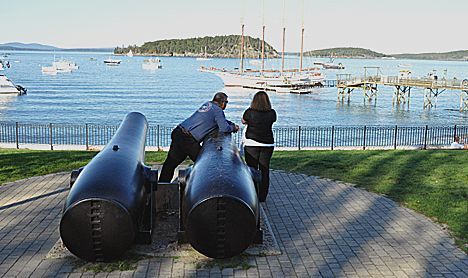
There are 6,200 islands off the coast of Maine and this island of 26 mountains and many lakes became of interest only to outdoorsmen — and artists. Two young artists of the Hudson River Valley School of Painting, Thomas Cole and Frederick Church arrived fascinated by the terrain in 1848, painted their hearts out and sold many canvases to the wealthy of Boston, New York and Philadelphia.
Their art patrons, intrigued, came up to have a look for themselves. They rented what rooms they could find. A hotel industry was born and by 1868 Bar Harbor had 30 hotels — one with 400 rooms but only 6 bathrooms!
This was not good enough for the elite of the East Coast. They started building and soon 260 magnificent homes rose up on Mt. Desert Island. The wealthy called their homes “cottages” because they were small compared to the mansions they had back home. One street in town was called “Millionaire’s Row” by the locals. The houses were monstrous and soon similar ones rose across the street for their guests and their servants.
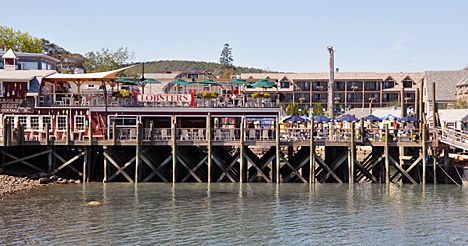
The little town of Bar Harbor came to mean money. It had opera and horse racing and rivaled the grandeur and the excesses of Newport, R.I., its rival farther south.
The Bar Harbor Club was built in the 1920s for the rich and the spoiled. Benny Goodman, Harry James and Louis Armstrong brought their bands to play at their parties. Party favors once included jewelry buried in the sand for guests to discover and keep. Butterfield’s Store on Main Street supplied the produce and party provisions and sometimes the bill for one party would be as high as $5,000 — at a time when money was money.
Those were favored times for the wealthy. There was no income tax and labor was cheap — and there was a golf course in town, today unchanged from those times.
“President Taft came to play,” says Claire Daniel, a local guide and historian. “He took 27 strokes in 1910 at the 17th hole — a par 4! We still call it the Taft Hole.”
Other celebrities came. J. P. Morgan often anchored his private yacht amongst the Porcupine Islands off shore. At 5 p.m. each day his servants would bring him his drink, an unfortunate time because that was when the trade winds blew. The ship would rock and he’d spill his drink. One day he’d had enough. He called the White House and said Bar Harbor needed a breakwater. The president obliged and Bar Harbor got its breakwater — at taxpayer expense.
Another celebrity was John D. Rockefeller.
“John D. made the family fortune,” says Daniel. “And John D. Rockefeller, Jr., spent it! But Jr. purchased one-third of the island and gave it to the nation.”
Other wealthy local homeowners joined in. Appalled at how fast the sawmills were savaging local forests, they bought up large tracts and when income tax became established handed them over as a tax saving and Acadia National Park was born.
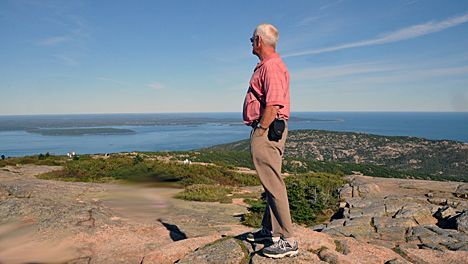
This national park, somehow, doesn’t receive the attention the great parks of the American South West get but it has its own attractions. For example, it has Thunder Hole, Maine’s version of Yellowstone’s Old Faithful — although it depends on the tides and the whims of the seas.
Otter Point is the highest headlands on the Eastern seaboard north of Rio de Janeiro. When visitors stand atop them and gaze out to sea they are looking in the direction of Nova Scotia and, beyond that, the coast of France, an appealing thought to the many French passengers on our Le Boreal. (The ship’s name aptly means from the North.) Arcadia National Park also can boast Cadillac Mountain, the highest mountain on the Eastern Seaboard, again, north of Rio. It was once thought to be the first place in the United States to see the day’s sunrise.
Convenient roads allow cars around the island. The parkland beyond the roads has been protected with pieces of the park’s distinctive pink granite. The granite has been harvested from some of the 26 mountains to build parts of Washington, D.C., Philadelphia and New York City.
Rockefeller, Jr., took a great interest in protecting the land he had given to the nation even to creating carriage roads for hiking and horse riding. He worked with the laborers in building the roads and selecting the chunks of granite as their barrier. He apparently had bad teeth and the locals rather unkindly call those irregular chunks of granite along the roads “Rockefeller Teeth.”
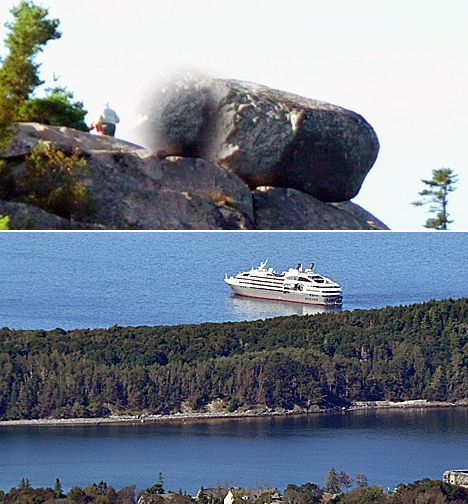
One piece of granite that commands more attention than most is the huge glacier erratic boulder perched as if poised to roll on top from one of the ridges in the park. Brought down by the glaciers that carved this island from 35 miles away and dumped when the glaciers melted, it is a local attraction. The University of Maine football team once tried to topple it and failed. It is estimated to weigh 57 metric tons.
Le Boreal
We squint up into the sun to see the boulder and the two persons standing beside it. Then, perched on top of Cadillac Mountain, we turn to see swaying at anchor below us — and below the boulder. We are glad the boulder is truly stuck; we would hate to have it roll into our cabin later in the night.
The Man Who Cried Orange: Stories from a Doctor's Life.
The Andersons, who live in San Diego, are the resident travel & cruise columnists for Physician's Money Digest. Nancy is a former nursing educator, Eric a retired MD. The one-time president of the NH Academy of Family Practice, Eric is the only physician in the Society of American Travel Writers. He has also written five books, the last called




